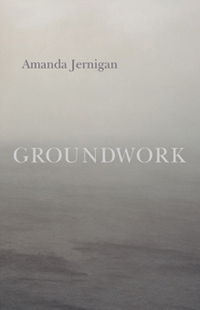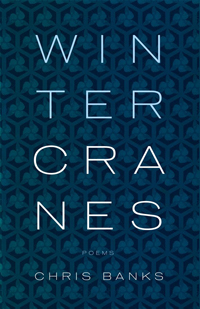Reviews
Poetry Review by Chris Jennings
Chris Banks, Winter Cranes (Toronto: ECW, 2011). Paperbound, 64 pp., $18.95.
Amanda Jernigan, Groundwork (Emeryville: Biblioasis, 2011). Paperbound, 64 pp., $17.95.
Outside of academic books on Milton, you don’t read many arguments about the poetic possibilities of sentence structure. This is too bad, because a poet’s approach to sentences can be a useful point of departure when thinking through a poem’s composition. Amanda Jernigan, whose Groundwork has both a broad ideational structure and a framework of familiar narratives, composes her poems in clear and direct sentences, often moving into the casual simplicity of direct speech in dramatic lyrics. Conversely, Chris Banks’s Winter Cranes often uses the long sentence to open up a play of sound, and parallel or digressive patterns of thought. Jernigan builds a context in which compression can thrive; Banks builds sentences that reflect the connections the associative mind sees in its subjects.
In Groundwork, the sequences “First Principals” and “Journeywork”
draw from  texts that are at the core of the Western tradition;
“First Principals” is grounded in the first few chapters of the Book of
Genesis, and “Journeywork” in the end of The Odyssey. This isn’t a
new game, but it is a proven one, especially as the backdrop for dramatic
lyrics where the emphasis on one character benefits from a near-to-
instant recognition that we’re in familiar surroundings. While the
game itself is almost a guilty pleasure, Jernigan plays it well. “Catch”
stacks layers of meaning in a deceptively simple moment: a game of
catch between a father and son. Father and son have a biblical resonance
where passing the ball is, metaphorically, the move from Old
Testament to the New Testament, from the alpha of Genesis to the
omega of Revelations (she could also intend Adam and Cain or Abel,
with Adam passing on original sin). Because the ball is “in the shape /
of the sun,” both modern science and classical myth intervene—the
red giant sun will “eat / its children” like the Titans of classical
mythology. The present moment of the poem steps out of biblical scenes; the speaker’s astronomical knowledge is an obvious clue, but
the poem works as well as it does because the ideas harmonize so
effectively with the rest of the sequence.
texts that are at the core of the Western tradition;
“First Principals” is grounded in the first few chapters of the Book of
Genesis, and “Journeywork” in the end of The Odyssey. This isn’t a
new game, but it is a proven one, especially as the backdrop for dramatic
lyrics where the emphasis on one character benefits from a near-to-
instant recognition that we’re in familiar surroundings. While the
game itself is almost a guilty pleasure, Jernigan plays it well. “Catch”
stacks layers of meaning in a deceptively simple moment: a game of
catch between a father and son. Father and son have a biblical resonance
where passing the ball is, metaphorically, the move from Old
Testament to the New Testament, from the alpha of Genesis to the
omega of Revelations (she could also intend Adam and Cain or Abel,
with Adam passing on original sin). Because the ball is “in the shape /
of the sun,” both modern science and classical myth intervene—the
red giant sun will “eat / its children” like the Titans of classical
mythology. The present moment of the poem steps out of biblical scenes; the speaker’s astronomical knowledge is an obvious clue, but
the poem works as well as it does because the ideas harmonize so
effectively with the rest of the sequence.
Some of the poems rely on the background texts more than others. “Odysseus on Watch” imagines the parallel back and forth (“boustrophedonic”) movement of Penelope’s shuttle and Odysseus’s ship tacking into a head wind, and the poem deepens if you at least know that Penelope was forever unravelling the day’s weaving; the sterility of her weaving makes the connection to Odysseus’s futile attempts to sail home that much more effective. “You Are So Strange” barely needs the frame at all. It needs only the ambivalence of the word strange to launch it from apparent insult to the stay against boredom in a long marriage: “we used to plunge ourselves in the routine, / and, surfacing, find each other rich and strange.” As much as this is deft, references to Circe and Ilion don’t add much you couldn’t find in any poem about marriage, raising the question of why the poems are framed in myth or the Bible at all.
The riposte to that idle wondering comes from the book’s structure. “Excavations” holds Groundwork together and establishes that Jernigan does not borrow from her sources naively. That first sequence centres on an archaeological dig in Tunis and speakers who voice the characteristic attitudes of their professions toward digging up remnants of the past. “The Night Guard,” “The Scholar,” or “The Photographer” models a relationship to physical archaeology that translates to the literary digging in which Jernigan engages. Foundational texts can be pillaged for personal gain, as by “The Smuggler,” or placed in the context of human change as by “The Physical Anthropologist”: “The living have quarried the bricks of the dead. / And why not? When the scholars leave, La Marsa men / will plant tomatoes in the font.” I don’t think the potential double meaning of “font” is an accident. The book is far more interesting because Jernigan places it in this self-reflexive intellectual frame, and her simple sentences and subtle diction are key in bringing that structure to the fore.
In the strongest poems in Winter Cranes, Chris Banks develops sonic
patterns across the syntax of long sentences. The best example of this
is “Riverland.” Its description of a sign marketing a new community
development makes the banal musical: “A community runs through
it, the sign / says beside the housing development, / painting images
of fly-fishermen / in hip waders, knee-deep in currents / pulling out
trout, one-handed, while / happily waving at men and women /
mowing lawns, grilling filet mignon / on backyard hibachis.” There’s
such an economy and flow of sound there, traversing the sibilant
sounds of the first two lines, through the short i’s of the third and
fourth lines to a hard stop perfect rhyme in “out trout,” the alternating
m’s and w’s, and the near rhyme of “lawn” and “mignon.” It’s a terrific
performance to underwrite an image that’s marketing the illusion of
an “uncommon life” that is inevitably ordinary: generic “rows / of
replica homes.” The last sentence of the poem also argues for the value
of forcing a reader to dwell on the language of a long sentence to parse
out its grammar. The sentence spans sixteen lines, with the antecedent
for “it” in the final phrase, “feel it leaving us,” coming six lines before
the pronoun. The effect is suspension followed by realization, a building
toward something that deflates in the way you can imagine
dreams of community deflating in the face of a typical new subdivision.
Given the tension Banks can create between sound and sentence
structure, it’s curious that he shears fairly close to simple prose in his
two prose poems; neither “Field Studies” nor “Garden Maze” is conspicuous
for long sentences or sonic effects.
the syntax of long sentences. The best example of this
is “Riverland.” Its description of a sign marketing a new community
development makes the banal musical: “A community runs through
it, the sign / says beside the housing development, / painting images
of fly-fishermen / in hip waders, knee-deep in currents / pulling out
trout, one-handed, while / happily waving at men and women /
mowing lawns, grilling filet mignon / on backyard hibachis.” There’s
such an economy and flow of sound there, traversing the sibilant
sounds of the first two lines, through the short i’s of the third and
fourth lines to a hard stop perfect rhyme in “out trout,” the alternating
m’s and w’s, and the near rhyme of “lawn” and “mignon.” It’s a terrific
performance to underwrite an image that’s marketing the illusion of
an “uncommon life” that is inevitably ordinary: generic “rows / of
replica homes.” The last sentence of the poem also argues for the value
of forcing a reader to dwell on the language of a long sentence to parse
out its grammar. The sentence spans sixteen lines, with the antecedent
for “it” in the final phrase, “feel it leaving us,” coming six lines before
the pronoun. The effect is suspension followed by realization, a building
toward something that deflates in the way you can imagine
dreams of community deflating in the face of a typical new subdivision.
Given the tension Banks can create between sound and sentence
structure, it’s curious that he shears fairly close to simple prose in his
two prose poems; neither “Field Studies” nor “Garden Maze” is conspicuous
for long sentences or sonic effects.
Sometimes Banks’s long sentences do not reward the untangling. “The Griffon,” is a single sentence, twenty-seven lines long, which can be reduced to: “it sleeps / at the bottom of Lake Michigan […] so we are forced to improvise a myth around / [it] […] as if something both permanent / and real could be salvaged by / a human desire pure enough / to haul what is left of its origins / all the way to the surface.” The poem, in dwelling on the facts of the lost ship, gets itself lost in the details and forgets the promise to improvise a myth. It’s also full of innocuous line breaks, on “enough” or “by” or “around,” that add little friction or variety to the expanding sentence. Compare it to “Riverland” on the facing page, and it seems clear that it’s the opening up of possibilities for other patterns of thought or sound that makes the long sentence work in Banks’s aesthetic. Most of the book is closer to “Riverland” in terms of matching compositional complexity to the depth of the idea. Winter Cranes is appealingly diverse in its subjects and moods, so the moments where the aesthetic grinds on its own challenges are something akin to an acceptable risk.
—Chris Jennings









